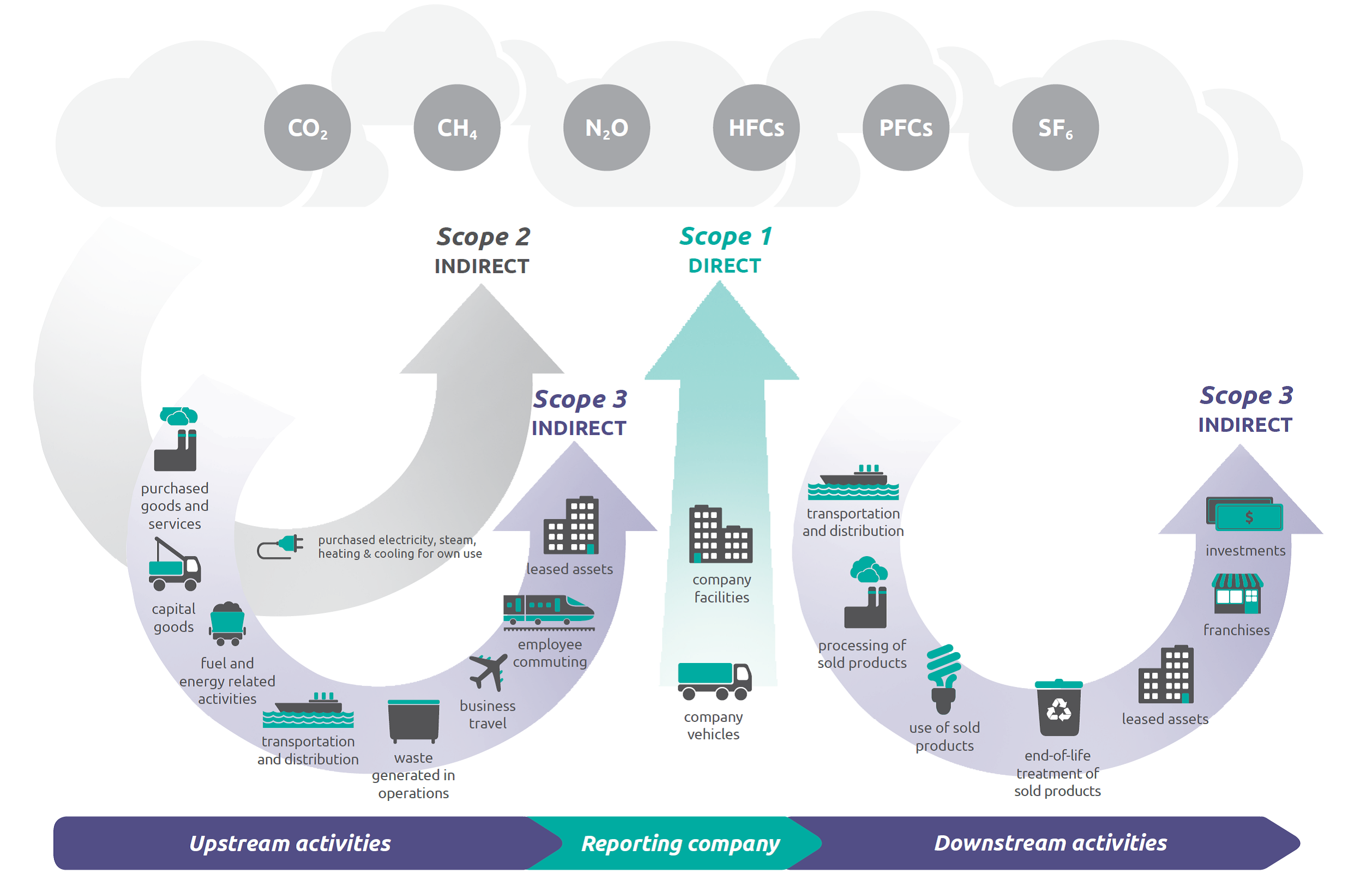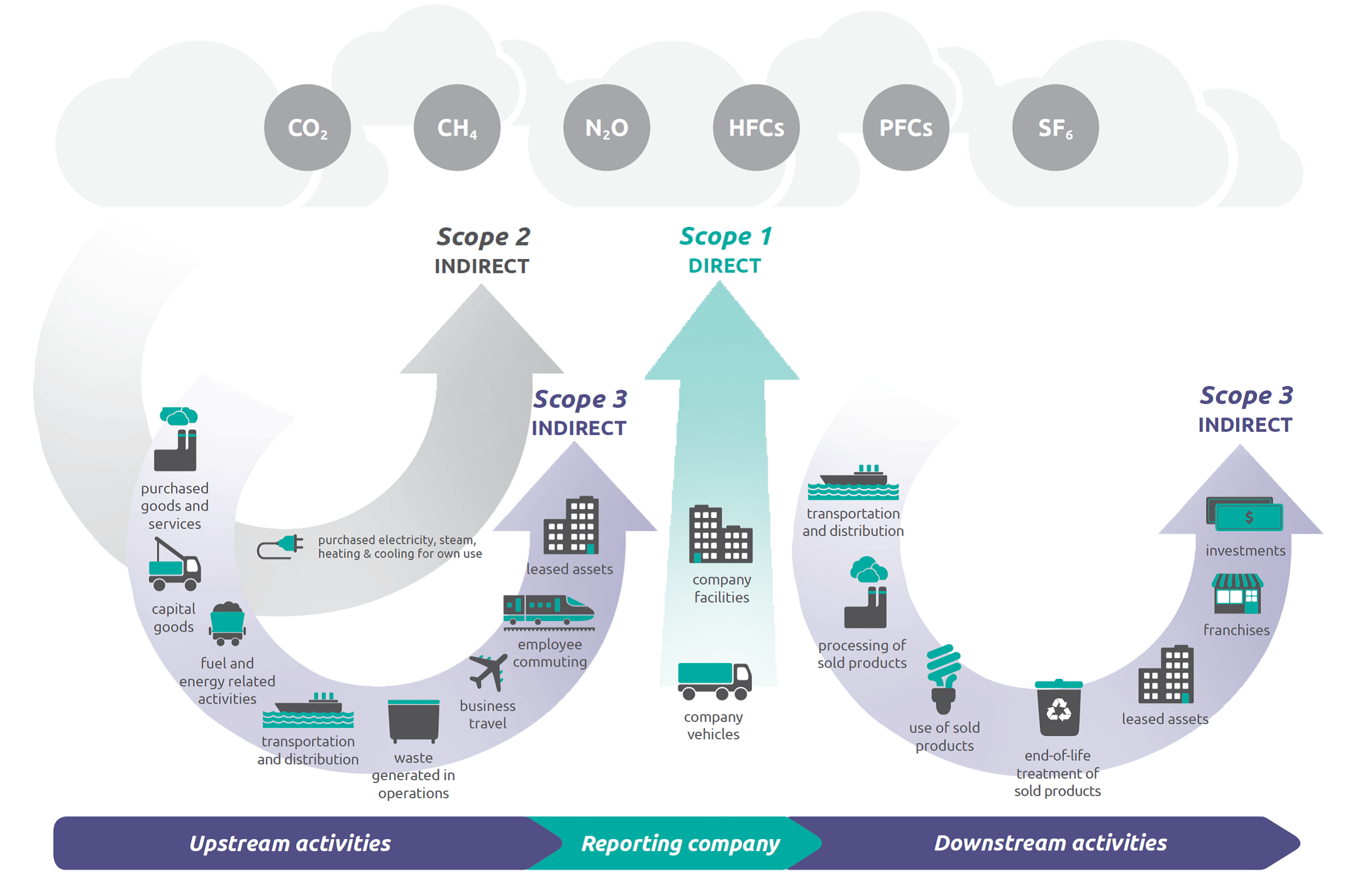GHG Inventory Diagram. Source: Greenhouse Gas Protocol
Reporting on Scope 3 emissions - those originating in a company’s value chain and beyond its direct control - will be included as part of required company disclosures under new standards being developed by the International Sustainability Standards Board (ISSB) of the IFRS Foundation, according to a statement Friday by the ISSB.
The decision marks a significant milestone in the development of climate and sustainability-related reporting standards for companies, as investors and other stakeholders increasingly demand information on companies’ management of climate risks and impact.
Regulators in major jurisdictions around the world including Europe, the UK and the U.S., among others, have introduced or are preparing mandatory sustainability reporting requirements for companies, and most will be heavily influenced by the ISSB standards. Understanding the basics of greenhouse gas emissions reporting is vital to your organisations’ success in emissions reduction efforts. Any plan to limit the effects of climate change requires an accurate assessment of greenhouse gas (GHG) emissions.
The IFRS said that the ISSB voted unanimously to require company disclosures on Scope 1, Scope 2 and Scope 3 greenhouse gas emissions at its October meeting, while also announcing that it will develop “relief provisions” in order to help companies apply the Scope 3 requirements. These provisions, to be decided at a later meeting, could include giving companies more time to provide Scope 3 disclosures, and working with jurisdictions to provide “safe harbour” provisions, giving companies protection or reduced liability on disclosed Scope 3 information. These provisions are like those included in the SEC’s initial proposal.
The ISSB is aiming to complete deliberations on its first 2 proposed standards for company sustainability and climate related disclosures around the end of this year, and to issue the final standards as early as possible in 2023.
What are Scope 1, 2, and 3 emissions?
Scope 1, Scope 2, and Scope 3 are categories of emissions defined by the GHG Protocol. These scopes are used by businesses, governments, and other organisations to report on their GHG emissions, as well as by regulators and NGOs to set targets for reducing carbon and other greenhouse gases.
The scopes are differentiated by how much control an organisation has over the sources of emissions.

GHG Inventory Diagram. Source: Greenhouse Gas Protocol
What are Scope 1 emissions?
Scope 1 GHG emissions are also called “direct” emissions. This scope encompasses emissions owned or controlled by the organisation. That means the organisation is directly involved in the action which releases the greenhouse gases, such as owning vehicles or facilities that combust fossil fuels.
Examples of Scope 1 emissions
- Emissions from combustion of fuel in a furnace or boiler
- Emissions from combustion of fuel in company vehicles
What are Scope 2 emissions?
Scope 2 GHG emissions are emissions generated from the purchase of electricity consumed by the organisation. These emissions are “indirect,” meaning the release of GHGs is physically occurring off-site on behalf of the organisation in question.
Examples of Scope 2 emissions:
- Emissions from the power plant to supply electricity to a building
- Emissions from the power plant to supply electricity used to charge electric vehicles
What are Scope 3 emissions?
Reporting requirements around Scope 3 emissions are one of the most controversial aspects of the emerging disclosure regimes. These emissions very often account for the vast majority of many companies’ carbon footprints, but are typically the hardest to track and calculate, occurring outside of the direct control of companies, in areas such as supply chains, or in their customers’ use of their products.
Examples of Scope 3 emissions:
- Emissions from the extraction of raw materials used in manufacturing
- Emissions from the manufacturing of products used by the organisation
- Emissions from the downstream usage of products or services
- Emissions from waste disposal
- Emissions from business travel
Reporting on Scope 1, 2, and 3 emissions
Reporting on Scopes 1, 2, and 3 involves collecting data about GHG output from various sources and compiling it according to the standards of the GHG Protocol or an equivalent international standard.
Previously, the GHG Protocol has set reporting on Scopes 1 and 2 as mandatory. These emissions are the easiest to collect data on, since they come from sources owned or directly influenced by the reporting organisation.
Scope 3 reporting had been optional, but strongly encouraged. The IFRS now states that the ISSB voted unanimously to require company disclosures on Scope 1, Scope 2 and Scope 3 greenhouse gas emissions.
For many organisations, Scope 3 emissions will account for about 70% of total GHG footprint. With the additional announcement that the IFRS will develop “relief provisions” in order to help companies apply the Scope 3 requirements, Rio is ready to help.
Rio helps organisations of all sizes to report on Scope 3, as well as gain a complete understanding of their impact on climate change and to better support their likelihood of hitting net zero targets. While it is true that scope 3 reporting is difficult when compared to Scopes 1 and 2, it’s also potentially the most important.
Our customers find that conducting comprehensive (aka “full-scope”) GHG reporting provides benefits that go beyond fulfilling requirements, including:
- Increased trust between the organisation, employees, and customers
- Identification of weaknesses and cost centres in the value chain
- Identification of opportunities to reduce energy costs
Reporting on emissions using a sustainability framework
Most organisations that report on GHG emissions do so using a recognised sustainability reporting framework. These frameworks help standardise reporting, provide guidelines for data collection, and enable greater transparency.
There are many sustainability frameworks out there, and selecting the right one for your organisation can be difficult. We put together this frameworks guide to help you choose.
Your guide to sustainability reporting frameworks
What about Scope 4 emissions?
You may have heard about an additional emissions category known as Scope 4. This is not an official category within the GHG Protocol and it is not mandated by any existing frameworks.
However, Scope 4 has been the focus of increased attention as organisations look to quantify the positive impact of their products or services that avoid GHG emissions.
Unlike the first three scopes, which refer to emissions produced as a result of an organisation’s actions, Scope 4 refers to avoided emissions. The most common example is emissions avoided by offering remote work (thereby reducing emissions from commuting and business travel). However, this is not to say that other emissions associated with working from home should be ignored entirely — organisations should still measure such emissions to gain an accurate overview of their footprint.
Learn more: What Is Scope 4? Reporting Avoided CO2 Emissions & More.
What’s next?
Understanding the basics of the GHG protocol and the different emissions scopes will help you as you begin reporting on your organisation’s emissions. Once you’ve established regular, comprehensive reporting, you can begin working towards your net zero targets and tracking progress over time.
Tracking and reporting on emissions is challenging. Rio’s intelligent sustainability software makes it simpler, automatically sorting emissions into Scopes 1, 2, and 3 using industry-standard guidance provided by the GHG Protocol.
Learn more about GHG reporting using Rio
We dig into the basics of the GHG Protocol, explain the different scopes, and discuss how organisations can use these standards in their reporting.










